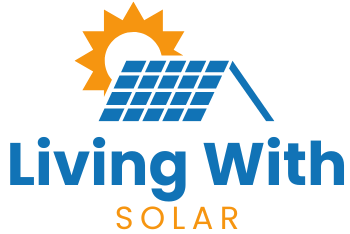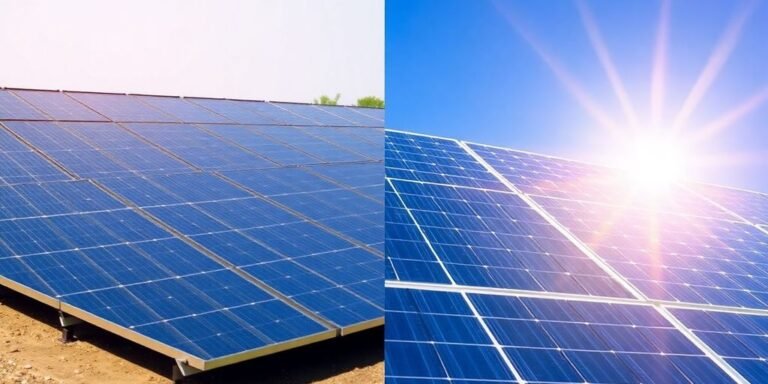So, here’s the deal with solar energy—everyone’s talking about it, but is it really renewable? When we say something’s renewable, we mean it can keep going without running out.
Like, the sun isn’t going anywhere anytime soon, right? Solar energy grabs the sun’s rays and turns them into electricity.
It’s a pretty neat trick, and it’s why solar is considered renewable. But there’s more to the story, like how we make those solar panels and what happens when they wear out.
Let’s dive into all that and see why solar energy is a big deal in the renewable world.
Key Takeaways
- Solar energy is renewable because it comes from the sun, which isn’t going away.
- Solar panels use the sun’s light to make electricity, so no fuel gets burned.
- Making solar panels does have some environmental impact, but it’s less than fossil fuels.
- Solar energy helps cut down on carbon emissions and is a cleaner option.
- Using solar power can lead to energy independence and job creation.
Want to know more about solar energy? we are just a click away. “Schedule a Free Consultation”
Understanding Solar Energy: Renewable or Non-Renewable
Defining Renewable Energy
Renewable energy comes from sources that naturally replenish themselves over time. Think of it like a never-ending supply. The sun, wind, and water are classic examples.
They don’t run out, at least not within any timeline that concerns us. These sources are sustainable and can be used repeatedly without depleting the Earth’s resources.
Characteristics of Non-Renewable Energy
Non-renewable energy, on the other hand, is like that one chocolate bar you have hidden away. Once it’s gone, it’s gone.
These are resources that exist in finite amounts on Earth. Fossil fuels like coal, oil, and natural gas fall into this category.
They take millions of years to form and are used up much faster than they can be naturally replenished.
Solar Energy’s Place in the Renewable Spectrum
Now, where does solar energy fit in? Well, solar energy is captured from the sun’s rays, which makes it a renewable resource. The sun is a massive, ongoing nuclear reaction that will continue for billions of years.
As long as it shines, we can harness its energy. Solar energy doesn’t get used up in the process of generating electricity, which is a key feature of renewable resources.
Solar energy is among the cleanest and most sustainable sources of power available today. It doesn’t emit greenhouse gases during electricity generation, making it an eco-friendly option for reducing carbon footprints.
How Solar Energy Works as a Renewable Source
Photovoltaic Effect Explained
Solar energy starts with the sun’s rays, and the magic happens through the photovoltaic effect. This is where sunlight hits solar panels, made mostly of silicon, and knocks electrons loose. These free electrons flow to create electricity.
It’s like a tiny electron dance party happening on your roof. The panels are set up to capture as much sunlight as possible, turning it into direct current (DC) electricity.
Solar Panels and Electricity Generation
Once the sunlight is converted to DC electricity, it needs to be changed to alternating current (AC) for everyday use. This is where the inverter comes in, switching DC to AC so it can power your home.
Solar panels can be installed on rooftops or in open areas as solar farms. They don’t just sit there looking pretty; they’re busy generating power, reducing the need for fossil fuels.
Storing Solar Energy for Future Use
You might wonder, “What happens when the sun goes down?” Solar energy can be stored in batteries for later use.
These batteries save the excess energy produced during sunny days, so you can use it at night or on cloudy days. It’s like having a backup plan for when the sun decides to take a break.
This storage capability makes solar energy even more reliable and is a game-changer for energy independence.
Environmental Impact of Solar Energy
Reducing Carbon Footprint with Solar
Solar energy is a game-changer when it comes to reducing our carbon footprint. Unlike fossil fuels, solar power generates electricity without emitting carbon dioxide.
This means a significant reduction in greenhouse gases. For every kilowatt-hour produced, solar energy emits only around 40 grams of CO2, compared to over 1,000 grams for coal. That’s a big deal for the planet.
Solar Energy and Greenhouse Gas Emissions
Solar panels are pretty impressive in the fight against greenhouse gases. They produce clean energy by harnessing the sun’s rays, which means no air pollutants or greenhouse gases are released during operation.
While the production of solar panels does have some emissions, these are offset over time. Once installed, solar panels can generate carbon-free electricity for 25 years or more.
Sustainability of Solar Panel Production
The sustainability of solar panel production is an ongoing concern. Manufacturing involves mining materials like silicon and metals, which have environmental impacts.
However, the industry is making strides towards greener production methods.
Recycling programs are also emerging, with more than 80% of a typical solar panel being recyclable. It’s a step towards making solar energy even more eco-friendly.
Solar energy offers a clean, renewable source of power that significantly reduces our reliance on fossil fuels.
As technology advances, solar is becoming more efficient and sustainable, paving the way for a greener future. The environmental benefits are clear, making solar a key player in the transition to renewable energy.
Comparing Solar Energy to Other Renewable Sources
Solar vs. Wind Energy
When it comes to renewable energy, solar and wind are often at the forefront of the conversation. Solar energy is harnessed from the sun’s rays, while wind energy is generated by converting the kinetic energy of wind into electricity using turbines.
One of the key differences lies in their availability; solar power is more predictable and consistent during daylight hours, whereas wind energy can be more intermittent and unpredictable.
However, both technologies have seen significant advancements, reducing costs and improving efficiency.
In terms of environmental impact, both solar and wind offer substantial benefits over fossil fuels, but they come with their own unique challenges, such as land use and wildlife disruption for wind farms.
The Role of Solar in a Renewable Energy Mix
In the quest for a sustainable energy future, a mix of different renewable sources is essential. Solar energy plays a crucial role in this mix due to its scalability and decreasing costs.
It can be effectively combined with other renewables like wind and hydropower to create a more resilient and reliable energy system.
By diversifying energy sources, we can better manage supply and demand fluctuations and reduce reliance on any single energy type.
The integration of solar energy into the broader renewable landscape not only enhances energy security but also supports the reduction of greenhouse gas emissions.
Challenges and Solutions in Solar Energy Adoption
Overcoming Material Harvesting Issues
Solar panels need a bunch of materials like copper and cadmium to be made. These materials have to be mined, which isn’t always great for the environment.
Mining can mess up the land and lead to pollution. But, there are ways to make it better.
Using recycled materials can cut down on the need for new mining. Plus, finding alternative materials that are easier on the earth is a good option too.
Innovative approaches in material sourcing can significantly reduce the environmental impact.
Addressing Solar Panel Disposal Concerns
When solar panels hit the end of their life—usually after 25 to 30 years—they can become a problem if not disposed of properly.
They contain toxic metals that can leak into the ground, which is bad news for the environment.
The good thing is, about 80% of a solar panel can be recycled. More recycling programs are popping up to handle this. Also, improving the design of panels to make them easier to recycle is a smart move.
Innovations in Solar Technology
The solar industry is always coming up with new ways to tackle these challenges. For example, better battery technology is being developed to store solar energy more efficiently. This means less waste and more reliable power.
New types of solar panels are also being designed to be more efficient and easier to recycle. By staying on the cutting edge of technology, we can make solar energy more sustainable and accessible.
Solar energy isn’t just about capturing sunlight; it’s about creating a sustainable future. With ongoing innovations and a focus on environmental responsibility, solar power can truly shine as a renewable resource.
For more insights on how the solar market is evolving and overcoming these challenges, check out this exploration of key trends in the industry.
The Future of Solar Energy as a Renewable Resource

Trends in Solar Energy Adoption
Solar energy is becoming more popular every year. More people and businesses are installing solar panels on their roofs. Governments are also supporting solar energy by offering tax breaks and incentives.
By 2025 and beyond, solar energy is expected to be pivotal in achieving a clean, renewable, and energy-independent future. This means that more countries will rely on solar power to meet their energy needs.
Technological Advancements in Solar Power
The technology behind solar panels is always improving. New materials and designs make solar panels more efficient and cheaper to produce.
Some new technologies include flexible solar panels and solar paint. These advancements mean that solar energy will become even more accessible to everyone.
Global Impact of Solar Energy Expansion
As solar energy becomes more widespread, it will have a big impact on the world. It can help reduce pollution and slow down climate change.
Solar energy can also help countries become less dependent on fossil fuels. This is important for the environment and for global politics. Solar energy is a key part of a sustainable future.
Economic Benefits of Solar Energy

Cost-Effectiveness of Solar Power
Investing in solar power can be a smart financial move. Many homeowners and businesses notice a significant drop in their electricity bills once they switch to solar.
By converting sunlight into electricity, solar panels help reduce reliance on traditional energy sources, which can be more expensive.
Over time, the savings on utility costs can offset the initial investment in solar technology. In some areas, government incentives and tax credits further enhance the financial appeal of going solar.
Job Creation in the Solar Industry
The solar industry is booming, and with it comes a surge in job opportunities. From manufacturing to installation and maintenance, solar energy supports a wide range of occupations.
This growth not only helps reduce unemployment but also stimulates local economies. As more people turn to solar, the demand for skilled workers in this field continues to rise, leading to more training programs and career opportunities.
Solar Energy and Energy Independence
Solar energy offers a path to greater energy independence. By harnessing the power of the sun, communities can reduce their dependence on imported fuels and traditional energy grids.
This shift not only promotes self-sufficiency but also enhances energy security.
With solar panels, individuals and businesses can generate their own electricity, sometimes even producing more than they need.
In such cases, excess energy can be fed back into the grid, often resulting in lower electricity costs and even potential earnings through net metering programs.
Embracing solar energy isn’t just about saving money—it’s about investing in a sustainable future. As more people adopt solar technology, the benefits ripple through the economy, creating jobs and fostering energy independence.
Conclusion
So, is solar energy renewable or non-renewable? Well, it’s definitely renewable. The sun’s not running out anytime soon, and as long as it keeps shining, we can keep using its energy.
Solar power is clean and doesn’t pollute the air or water. Sure, making solar panels isn’t perfect, but the benefits outweigh the downsides. Plus, the tech is getting better all the time.
If you’re thinking about going solar, it’s a solid choice for the planet and your wallet. Just make sure to recycle those panels when they’re done. It’s a win-win for everyone.
Frequently Asked Questions
Is solar energy renewable?
Yes, solar energy is renewable because it comes from the sun, which is a resource that won’t run out for billions of years.
How do solar panels work?
Solar panels capture sunlight and convert it into electricity using a process called the photovoltaic effect.
What are the benefits of using solar energy?
Solar energy helps reduce carbon emissions, lowers electricity bills, and is a clean source of power.
Can solar panels store energy for later use?
Yes, solar panels can store energy in batteries, allowing you to use the power even when the sun isn’t shining.
How does solar energy compare to other renewable sources?
Solar energy is abundant and can be used anywhere the sun shines, making it a versatile option compared to wind or hydropower.
What challenges does solar energy face?
Challenges include the cost of installation, material sourcing, and recycling of old panels, but technology is improving to address these issues.




